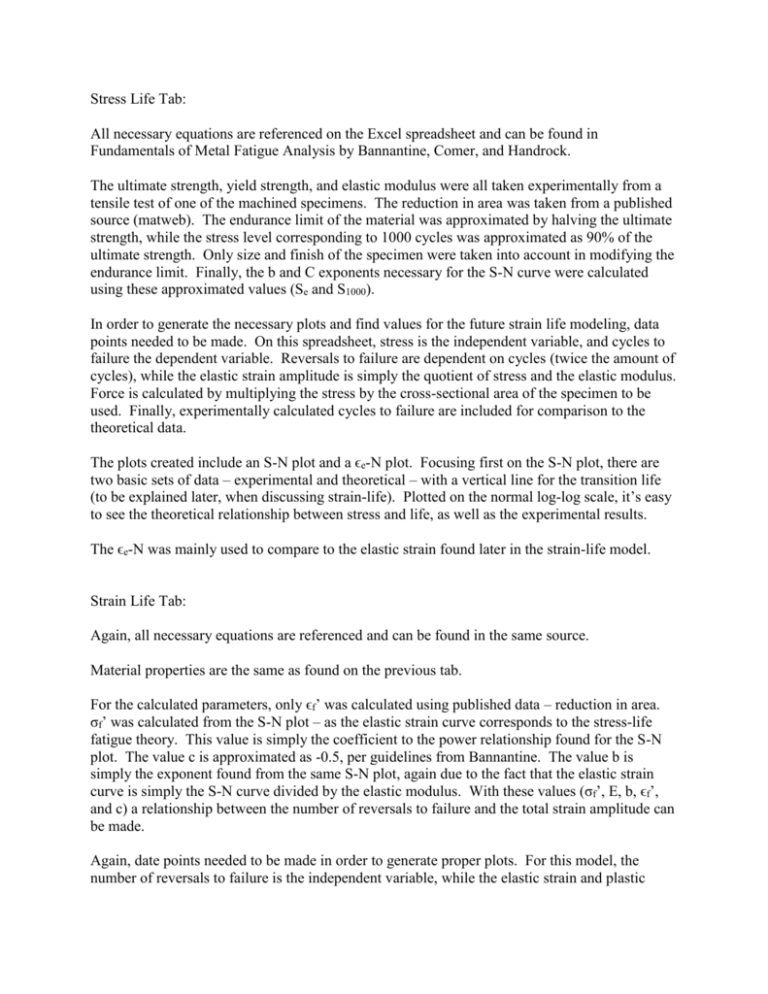display
advertisement

Stress Life Tab: All necessary equations are referenced on the Excel spreadsheet and can be found in Fundamentals of Metal Fatigue Analysis by Bannantine, Comer, and Handrock. The ultimate strength, yield strength, and elastic modulus were all taken experimentally from a tensile test of one of the machined specimens. The reduction in area was taken from a published source (matweb). The endurance limit of the material was approximated by halving the ultimate strength, while the stress level corresponding to 1000 cycles was approximated as 90% of the ultimate strength. Only size and finish of the specimen were taken into account in modifying the endurance limit. Finally, the b and C exponents necessary for the S-N curve were calculated using these approximated values (Se and S1000). In order to generate the necessary plots and find values for the future strain life modeling, data points needed to be made. On this spreadsheet, stress is the independent variable, and cycles to failure the dependent variable. Reversals to failure are dependent on cycles (twice the amount of cycles), while the elastic strain amplitude is simply the quotient of stress and the elastic modulus. Force is calculated by multiplying the stress by the cross-sectional area of the specimen to be used. Finally, experimentally calculated cycles to failure are included for comparison to the theoretical data. The plots created include an S-N plot and a ϵe-N plot. Focusing first on the S-N plot, there are two basic sets of data – experimental and theoretical – with a vertical line for the transition life (to be explained later, when discussing strain-life). Plotted on the normal log-log scale, it’s easy to see the theoretical relationship between stress and life, as well as the experimental results. The ϵe-N was mainly used to compare to the elastic strain found later in the strain-life model. Strain Life Tab: Again, all necessary equations are referenced and can be found in the same source. Material properties are the same as found on the previous tab. For the calculated parameters, only ϵf’ was calculated using published data – reduction in area. σf’ was calculated from the S-N plot – as the elastic strain curve corresponds to the stress-life fatigue theory. This value is simply the coefficient to the power relationship found for the S-N plot. The value c is approximated as -0.5, per guidelines from Bannantine. The value b is simply the exponent found from the same S-N plot, again due to the fact that the elastic strain curve is simply the S-N curve divided by the elastic modulus. With these values (σf’, E, b, ϵf’, and c) a relationship between the number of reversals to failure and the total strain amplitude can be made. Again, date points needed to be made in order to generate proper plots. For this model, the number of reversals to failure is the independent variable, while the elastic strain and plastic strain amplitudes are the dependent variables. The total strain amplitude is the sum of the elastic strain and plastic strain amplitudes. To visualize this, strain amplitude was plotted versus the number of reversals to failure on a log-log plot. Both the elastic strain and plastic strain curves are linear, since they follow a power relationship, while the sum of the two creates a curve. To fully explain this plot, transition life must be examined. The transition life is the life at which the plastic strain is equal to the elastic strain. For lives greater than the transition life, elastic strain dominates plastic strain. In this region, stress-based fatigue models are sufficient, as the plastic strain becomes increasingly less influential as the cycles to failure increase. For lives less than the transition life, plastic strain dominates elastic strain. In this region, strain-based fatigue models are necessary, as stress-based theories fail to account for plastic deformation. Transition life may be represented as both reversals or cycles, and is shown as both on this spreadsheet. The vertical line seen on the plot represents the transition life for this material and specimen geometry. Finally, experimental data is included. Since experiments were done in load control, the total strain had to be calculated from the stress – shown in the first column. The number of reversals is twice the amount of cycles that each specimen survived. The final plot shows all three theoretical curves – elastic strain, plastic strain, and total strain – along with the experimental data and a demarcation for the transition life. Comparison: Looking first at the stress-life plot, it becomes immediately clear that specimens cycled to fail higher than the transition life match quite well with the S-N curve, while those below the transition life deviate. This is expected, as the S-N curve does not take into account the plastic strain experienced by the specimens and thus cannot accurately predict life in this region. The strain-life plot, however, shows better overall correlation. Experimental data points are expected to match with the total strain curve. The specimens that were cycled to a high amount of cycles match well with the total strain curve. Those below the transition life match well, too, save for a few outliers. These outliers that do not match well with the strain-life plot exhibited buckling – well below the theoretical value of force needed for buckling. A probably misalignment of the test system is to blame for this. Since the specimens buckled, they were subjected to bending instead of just axial loading. All theoretical calculations were done assuming axial loading, and thus these buckled specimens cannot be expected to correlate with theoretical values.







